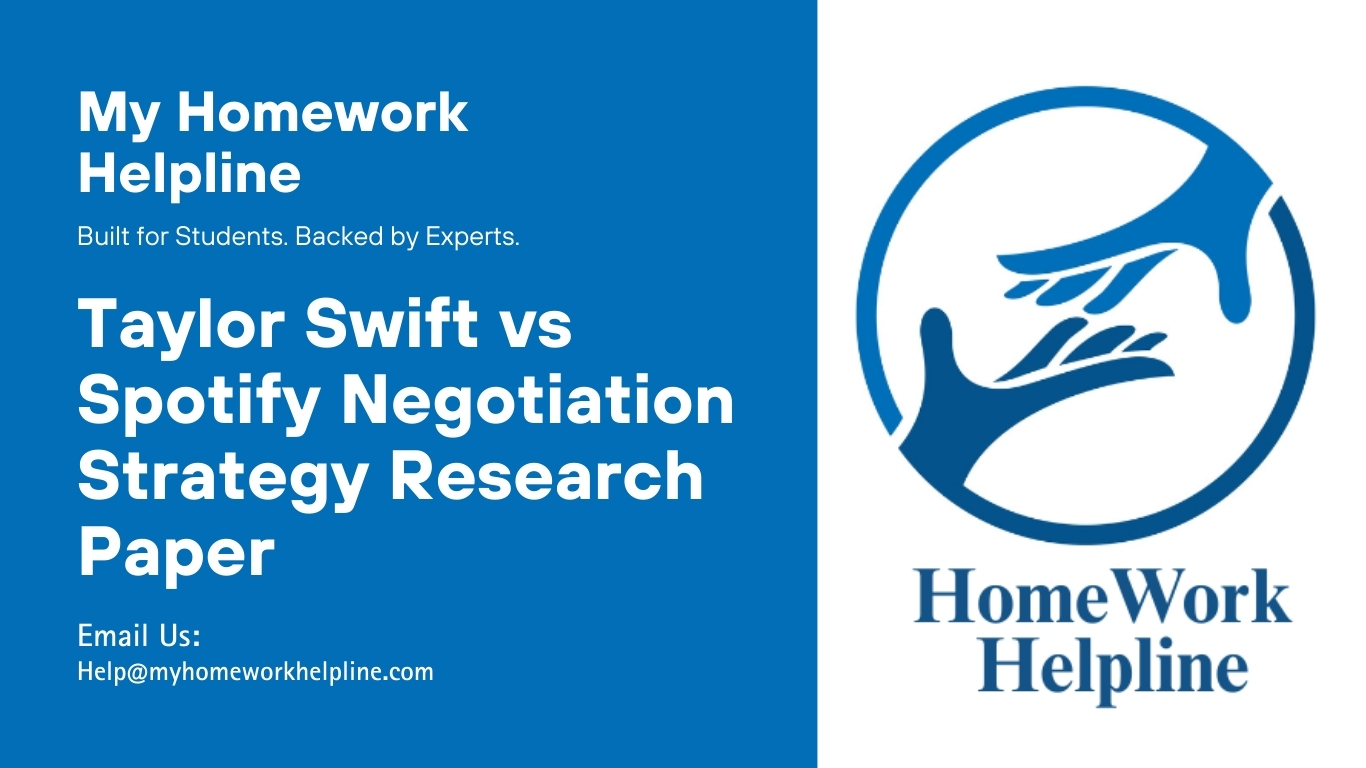Taylor Swift vs Spotify Negotiation Strategy and Tactics Research Paper
The negotiation between Taylor Swift, the country-music star, and Spotify, the music streaming entity was unique as it took less than one year, but it indirectly lasted for three years. Such is the case since Swift initiated the negotiation in 2014 and since Spotify did not give in to her demands, she protested the outcomes up to 2017, when she reinstated her contract with Spotify. The specific negotiation strategies and tactics characterized the peculiar Swift vs Spotify negotiation.
Strategy
Swift employed a distributive negotiation strategy. The approach encompasses sticking to a fixed deliberation item. Shonk argues that price is often the primary point of contention. Swift was concerned with how Spotify compensates artists when fans are still in the free tier, which is termed as the three-month free trial. Swift enhanced her strategy by having the best alternative to a negotiated agreement (BATNA). A negotiator needs to boost his/her BATNA through extensive research (Shonk). Swift’s BATNA was for Spotify to scrap the free tier category if it was not going to pay artists during a customer’s free trial period. Swift also had a reservation point which was to work away if Spotify would neither agree to pay her for every client who accesses her ‘1989’ album nor accept her BATNA. Moreover, Swift considered a probable zone of possible agreement (ZOPA). ZOPA refers to the range of all the potential points of agreement, which could accommodate the demands of both sides (Shonk). Accordingly, Swift reached her reservation point of withdrawing from Spotify at the end of the ZOPA.
Studying business negotiation strategies, tactics, and outcomes can be complex without guidance. Our business studies homework helpline support provides expert assistance with research papers, essays, and assignments in negotiation analysis, corporate strategy, and case studies. With reliable solutions tailored to your coursework, you can strengthen your understanding, improve your grades, and gain valuable insights into real-world business scenarios like the Taylor Swift vs Spotify case.
Spotify deployed an integrative negotiation strategy. Integrative negotiation is elaborate and more accommodative than distributive negotiation. The strategy comprises negotiating with multiple items on the table and the parties have the potential to strike win-win agreements (Barthelmess et al. 38). As opposed to Swift, who wanted an exclusively one-sided win, Spotify desired a mutually beneficial deal. The digital music company had to balance meeting the needs of all the stakeholders, who include the musicians, customers, and investors. Spotify enhanced its integrative negotiation strategy through various ways, which compose designing innovative and creative options, brainstorming how to utilize tradeoffs, and boosting its trust among the stakeholders (PON Staff). Accordingly, Spotify launched drives to attract and retain the most number of Swift’s fans and transformed its business model to motivate the musician as well as entice other top artists.
Tactics
Swift used multiple tactics to push her distributive negotiation. First, the country-music musician forged extreme demands and then slowly exhibited slow concessions. The tactic enables the negotiators to hold onto their demands without conceding too early, making the negotiation take longer time (Schwartzman 3). Swift gave Spotify strict demands at first and she slowly conceded after three years. Nonetheless, the tactic can hinder the parties from making any progress as was the case for Swift vs Spotify. Secondly, Swift deployed the take-it-or-leave-it tactic. The technique involves submitting almost nonnegotiable offers on the negotiation table (Iwry 366). Correspondingly, Swift gave Spotify demands without counter-offers. Thirdly, Swift used threats and warnings. Swift was hard on Spotify because she felt the online music service company was exploiting the musicians by not paying them for free tier music streams. Therefore, it was either Spotify eliminate the free tier group or she discontinue her engagement and eventually, Swift made good her threats.
Spotify applied various tactics to advance its integrative negotiation strategy. First, Spotify employed commitment tactics. One party in the negotiation can use commitment tactics if the other party claim to have limited options (PON Staff). Spotify had to analyze Swift’s limited options brought onto the negotiation table to establish if they were genuine commitments, which then informed the company’s final stance. Secondly, Spotify invited unreciprocated offers. The tactic involves sticking to the first offer and demanding that the other party render a counteroffer before conceding (Ebrahimnezhad and Katsuhide 642). Spotify did not concede to Swift’s demand without her making a counteroffer. Thirdly, Spotify resisted coercion. In some negotiation instances, the opponent can attempt to make the other flinch by continually pushing forward the hard demands (PON Staff). Ultimately, Spotify did not give in to Swift’s tough minimums.
Reflection
The strategy and tactics each side used shaped the progress and outcomes of the Swift vs Spotify negotiation. The distributive negotiation and its enforcement tactics, which Swift used made it difficult for the two parties to broker a deal. In this respect, the restrictive strategy and tactics limited the negotiation’s ZOPA. On the other hand, the integrative strategy and its accompanying tactics, which Spotify employed eased the negotiation by inviting the parties to have a broader view of the discussion issues. Accordingly, despite Swift reaching her reservation point, she later recalled her resolution in favor of Spotify. Remarkably, I would utilize the integrative strategy enforced through improving my BATNA, researching ad creating appropriate reservation points and ZOPA, and exhibiting some resistance to manipulation if I find myself in a similar scenario.
Swift became too hard on Spotify and hence the failure to attain a concession. I perceive that Swift was not ready to negotiate while Spotify was willing to broker a deal, which will benefit all the stakeholders affected. It is unfortunate that sometimes negotiators become selfish and stick to hard-bargaining tactics (PON Staff). For instance, threats and warnings undermine the negotiations as was the case in the Swift vs Spotify negotiation. Remarkably, I have learned the significance of using negotiation strategies and tactics that give negotiators room to consider diverse options to the negotiation stalemate.
Works Cited
Barthelmess, Petra Y., et al. “Navigating Ambiguity: Distributive and Integrative Negotiation Tactics in China.” Central European Business Review, vol. 7, no. 2, 2018, pp. 21-43.
Ebrahimnezhad, Arash, and Katsuhide Fujita. “NegoSim: A Modular and Extendable Automated Negotiation Simulation Platform Considering EUBOA.” Applied Sciences, vol. 13, no. 1, 2023, pp. 642.
Hughes, Jonathan, and Ertel Danny. What’s Your Negotiation Strategy? Here’s How to Avoid Reactive Deal Making. Harvard Business Review, July-Aug. 2020. https://hbr.org/2020/07/whats-your-negotiation-strategy. Accessed 11 Feb. 2023.
Iwry, Jonathan. “Open to Debate: Reducing Polarization by Approaching Political Argument as Negotiation.” Negotiation Journal, vol. 37, no. 3, 2021, pp. 361-391.
PON Staff. (2022, October 10). 10 Hard-Bargaining Tactics to Watch Out For in a Negotiation: The Best Hard-Bargaining Tactics Can Catch You Off Guard. Program on Negotiation: Harvard Law School. https://www.pon.harvard.edu/daily/batna/10-hardball-tactics-in-negotiation/. Accessed 11 Feb. 2023.
Schwartzman, Rachel. “Utilizing Final-Offer Arbitration to Settle Divorces: A Proposal and Analysis.” Family Law Quarterly, vol. 53, no. 1, 2019, pp. 3-25.
Shonk, Katie. What is Distributive Negotiation? Program on Negotiation: Harvard Law School, 20 Dec. 2022. https://www.pon.harvard.edu/daily/negotiation-skills-daily/what-is-distributive-negotiation/. Accessed 11 Feb. 2023.

